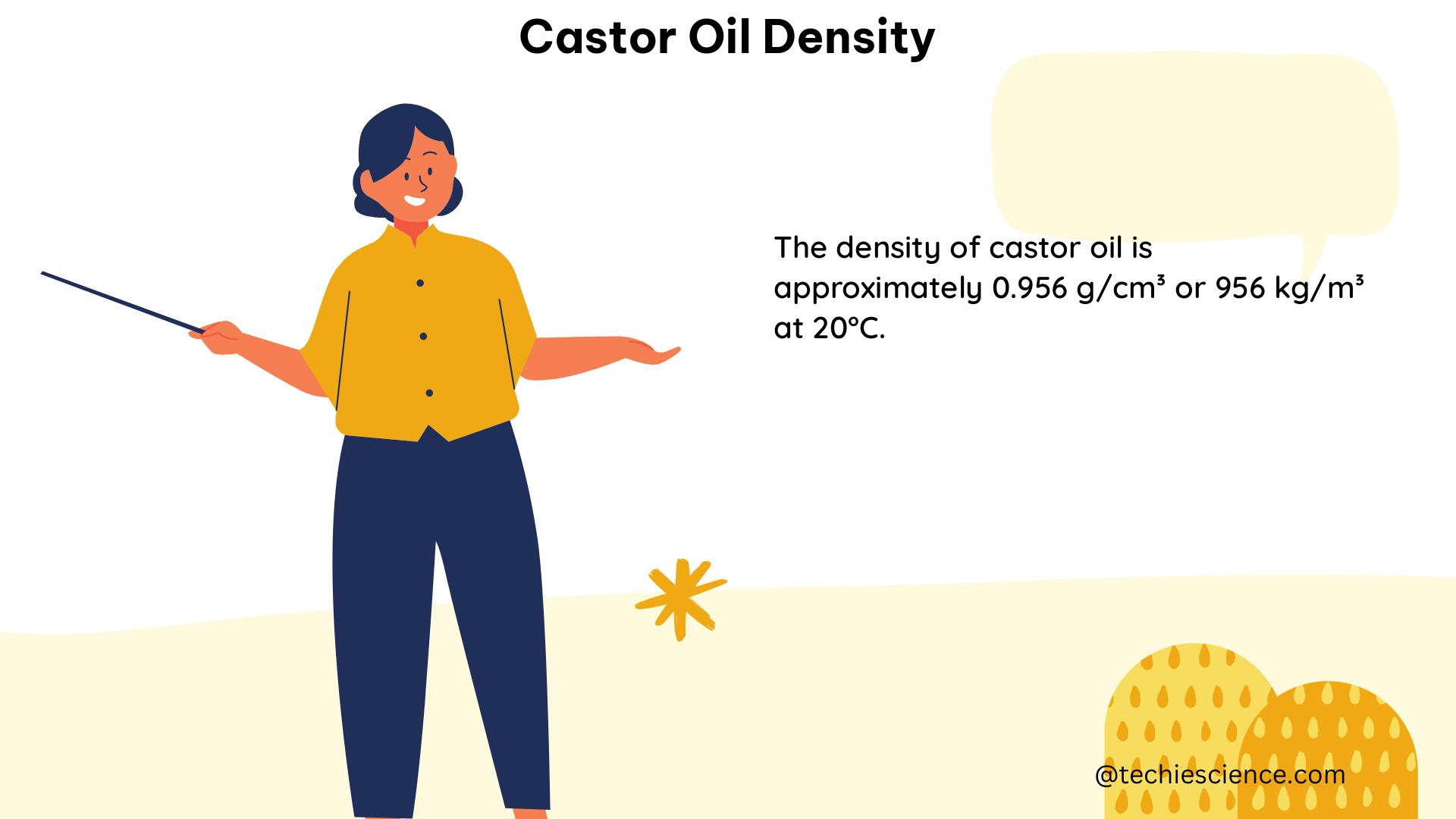Castor oil is a versatile and widely used natural oil that has a unique set of physical properties, including a high density of 0.959 g/mL at room temperature. This density is higher than that of many other common lubricants, making castor oil a valuable resource in various industrial and commercial applications. In this comprehensive guide, we will delve into the intricacies of castor oil density, exploring its underlying principles, practical applications, and numerical examples to provide a thorough understanding for physics students and enthusiasts.
Understanding Castor Oil Density
Theorem
- The density of a substance is defined as its mass per unit volume.
- The density of a substance can be measured using a hydrometer or a pycnometer.
- The density of a substance can be affected by temperature, pressure, and the presence of other substances.
Physics Formula
- Density (ρ) = mass (m) / volume (V)
- Specific gravity (SG) = density of a substance / density of water
Physics Examples
- A block of castor oil has a mass of 100 g and a volume of 105 cm³. What is the density of the castor oil?
- Density = mass / volume
- Density = 100 g / 105 cm³
-
Density = 0.952 g/cm³
-
A sample of castor oil has a density of 0.952 g/cm³. What is its specific gravity?
- Specific gravity = density of a substance / density of water
- Specific gravity = 0.952 g/cm³ / 1 g/cm³
- Specific gravity = 0.952
Physics Numerical Problems
- A container holds 500 mL of castor oil. What is the mass of the castor oil in grams?
- Mass = density × volume
- Mass = 0.959 g/mL × 500 mL
-
Mass = 479.5 g
-
A block of castor oil has a mass of 200 g. What is its volume in milliliters?
- Volume = mass / density
- Volume = 200 g / 0.959 g/mL
- Volume = 208.6 mL
Factors Affecting Castor Oil Density

The density of castor oil is influenced by several factors, including temperature, pressure, and the presence of other substances. Understanding these factors is crucial for accurately measuring and utilizing castor oil in various applications.
Temperature
The density of castor oil is inversely proportional to temperature. As the temperature increases, the density of castor oil decreases due to the expansion of the oil molecules. Conversely, as the temperature decreases, the density of castor oil increases.
Pressure
The density of castor oil is also affected by pressure. As the pressure increases, the density of castor oil increases due to the compression of the oil molecules. Conversely, as the pressure decreases, the density of castor oil decreases.
Presence of Other Substances
The presence of other substances, such as impurities or additives, can also affect the density of castor oil. The addition of these substances can either increase or decrease the overall density of the oil, depending on their own densities and the concentration within the castor oil.
Applications of Castor Oil Density
The high density of castor oil, along with its other unique physical properties, makes it a valuable resource in various industrial and commercial applications. Some of the key applications of castor oil density include:
- Lubricants: The high density and viscosity of castor oil make it well-suited for use as a lubricant in industrial machinery, engines, and other equipment.
- Hydraulic fluids: The high density and thermal conductivity of castor oil make it an effective hydraulic fluid for use in various hydraulic systems.
- Cosmetics and personal care products: The density of castor oil is a crucial factor in the formulation of various cosmetic and personal care products, such as lotions, creams, and hair care products.
- Biofuels: The high density of castor oil makes it a suitable feedstock for the production of biodiesel and other biofuels.
- Paints and coatings: The density of castor oil is an important consideration in the formulation of paints, varnishes, and other coatings.
Figures and Data Points
Figure 1: A graph showing the increasing number of castor oil studies published since the 1980s.
Figure 2: A photograph of castor beans.
Figure 3: A diagram showing the chemical structure of ricinoleic acid, the main component of castor oil.
Data Points:
– The density of castor oil is 0.959 g/mL.
– The viscosity of castor oil is 889.3 centistokes.
– The thermal conductivity of castor oil is 4.727 W/m°C.
– The specific heat of castor oil is 0.089 kJ/kg/K.
– The flash point of castor oil is 145°C.
– The pour point of castor oil is 2.7°C.
– The melting point of castor oil is -2 to -5°C.
– The refractive index of castor oil is 1.480.
Conclusion
The density of castor oil is a crucial physical property that plays a significant role in its various applications. By understanding the underlying principles, formulas, and numerical examples related to castor oil density, physics students and enthusiasts can gain a comprehensive understanding of this versatile natural oil and its practical uses. The data points and figures provided in this guide further enhance the understanding of castor oil’s physical characteristics and its potential in diverse industries.
References:
– Castor Oil: Properties, Uses, and Optimization of Processing Conditions in Commercial Production
– Castor Oil: Properties, Uses, and Optimization of Processing Conditions in Commercial Production
– Castor Oil: Properties, Uses, and Optimization of Processing Conditions in Commercial Production

The lambdageeks.com Core SME Team is a group of experienced subject matter experts from diverse scientific and technical fields including Physics, Chemistry, Technology,Electronics & Electrical Engineering, Automotive, Mechanical Engineering. Our team collaborates to create high-quality, well-researched articles on a wide range of science and technology topics for the lambdageeks.com website.
All Our Senior SME are having more than 7 Years of experience in the respective fields . They are either Working Industry Professionals or assocaited With different Universities. Refer Our Authors Page to get to know About our Core SMEs.